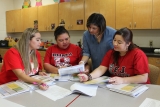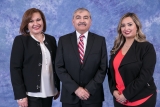-
Category 1
Selected in 2016
-
Grades: pre k - 5
School Setting: rural
Town Population: 9,900
Student Enrollment: 630
Student Demographics:
Black/African American: 0%
Teacher/Student Ratio: 1:20
White/Caucasian: 0%
Hispanic: 100%
Hawaiian/Pacific Islander: 0%
Asian: 0%
Native American: 0%
Other: 0%
% Reduced Lunch: 91%
% ELL Learners: 88%
Founded: 1957 -
PRINCIPAL:
Diana Salinas -
CONTACT:
800 P.F.C. Angel J. Moreno St.
Roma, TX 78584
956-849-1175
dsalinas5@romaisd.com
F. J. Scott Elementary
Roma, TX
Parents and community members play an integral role in the school community. “Together, we make the ordinary, Extraordinary.”
- Describe the most successful activity your school has initiated to strengthen ties to your community.
-
Parents and community members play an integral role in the school community. “Together, we make the ordinary, Extraordinary.” We work diligently to establish a welcoming environment for parents and community members to encourage a strong partnership with both groups. Parents are urged to become active participants in their child’s education. Keeping parents abreast about their child's progress and school happenings is crucial. Information is conveyed via, letters, phone calls, conferences, home-visits, campus web-page, parent portal, and social media networks. Recently, our Facebook page has enabled us to create an even stronger communication network with our parents and has helped strengthen ties with our community. All student activities, including pictures of classroom lessons, parent meeting information and school programs are uploaded to this page, enabling access to what is going on in our school on a daily basis and enhancing the partnership between the school community.
- Describe the program or initiative that has had the greatest positive effect on student achievement, including closing achievement or opportunity gaps, if applicable.
- A significant factor contributing to our success is a clearly defined focus on the academic success of all students. Demographic factors will not hold students back. The fusing together of the school community sets us apart and has brought about high levels of success for all student groups: “One Family, One Goal-Student Achievement, No Excuses.” Research based instructional strategies and the use of technology have been implemented to meet individual student needs and have proven to be effective amongst all student groups. These Interactive lessons and activities actively engage all learners, stimulate thinking, and build comprehension. Students experiencing difficulty are provided with additional time and support but continue to be held accountable for the same standards with the same high expectations. Differentiation occurs during instructional delivery. Emphasis is placed on ensuring teachers understand that effective and differentiated instruction is not “more of the same.”
- Identify the critical professional development activities you use to improve teaching and student learning.
- Research has continuously indicated that the most significant factor impacting student achievement is the effectiveness of the teacher. Building teacher capacity is top priority. Professional development activities are based on needs assessment and data results. Professional Learning Community Sessions (PLC's) play a major role in staff development, are held weekly, and are “non-negotiable.” PLC’s promote self-reflection, a deep focus on learning, build a collaborative culture, and focus on results. They improve teacher effectiveness and ensure high levels of student learning. PLC’s focus on 4 critical questions: Are teachers clear on what students must learn? Are students learning? How do we know? What are we doing for our strugglers and/or high achievers? Areas of focus include: Planning, Instruction/Assessment, Classroom Environment and Professional Growth. Building teacher capacity ensures all students exposure to the most optimal learning opportunities.
- Describe how data is used to improve student achievement and inform decision making.
- Data analysis enables teachers to make appropriate instructional decisions. Teachers discuss student data in weekly PLC sessions and submit results to campus administrators for monitoring. These results are used to plan and adjust instruction, resources and in the delivery of instruction. Immediate feedback is provided and communicated to parents. Local assessment data is reported through our data management system on a six weeks basis. Assessment results are analyzed by subject and demographic group by staff and administrators. Careful analysis of this data helps the campus team identify student strengths and weaknesses and helps track student performance and growth. Identified questions are flagged and thoroughly analyzed by the campus team to determine the cause. The teams consider whether this was a curriculum or an instructional delivery issue. DMAC data helps teachers make necessary adjustments on timelines and assessments, and plan instruction and interventions accordingly.
- Describe your school culture and explain changes you’ve taken to improve it.
-
The campus culture at F. J. Scott Elementary has been a leading contributor to the high levels of success. Commitment, passion, willingness to go above and beyond, unity, and a continuous drive to improve has allowed this campus to soar to great heights. Building teacher capacity “Seeking treasures” in each individual teacher has positively impacted the campus culture. Building teacher capacity through PLCs has fostered professional growth and support, and has also enhanced teacher effectiveness. Vertical team building has brought about the embracing of campus wide accountability and has strengthened the level of collaboration across grade levels. This team has become one “family” with one goal in mind, “Student Excellence.” “Whatever it takes, the students at F. J. Scott are worth it.” This mindset has greatly impacted student achievement. Together we celebrate our successes and see them as a starting point, as a challenge, to continue seeking ways to improve.
Stats
-
Category 1
Selected in 2016
-
Grades: pre k - 5
School Setting: rural
Town Population: 9,900
Student Enrollment: 630
Student Demographics:
Black/African American: 0%
Teacher/Student Ratio: 1:20
White/Caucasian: 0%
Hispanic: 100%
Hawaiian/Pacific Islander: 0%
Asian: 0%
Native American: 0%
Other: 0%
% Reduced Lunch: 91%
% ELL Learners: 88%
Founded: 1957 -
PRINCIPAL:
Diana Salinas -
CONTACT:
800 P.F.C. Angel J. Moreno St.
Roma, TX 78584
956-849-1175
dsalinas5@romaisd.com











